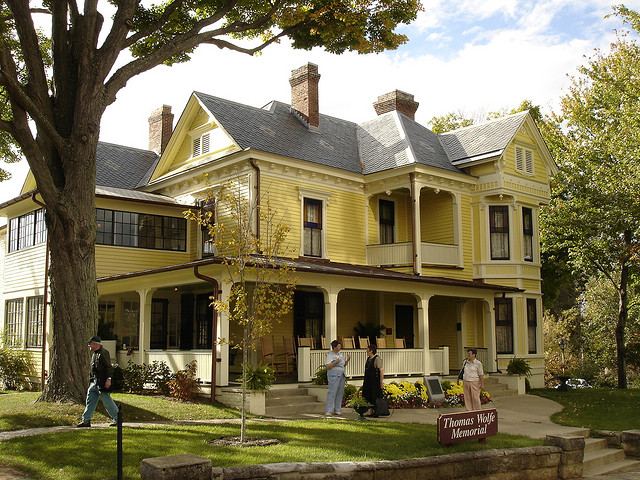
Creative Commons Image Obtained Through Wikimedia
Thomas Wolfe was born to Julia and W.O. Wolfe in 1900. The youngest of eight children, he grew up living in the boardinghouse operated by his mother in Asheville, North Carolina. His childhood experiences influenced him greatly and aided the development of his future literary topics. Known as Asheville’s favorite son, he eventually became one of America’s most famous authors. The characters in his 1929 bestseller, Look Homeward, Angel, are loosely based on members of his family and other Asheville citizens. Upon its publication, the depictions were deemed so scandalous that Wolfe and his family were severely criticized in their hometown. This led to another book with the now-famous anecdotal title, You Can’t Go Home Again. However, history and Asheville have forgiven Thomas Wolfe. Today he is remembered by his works and honored by a State Historic Site preserving his boyhood home annexed to a modern museum – all located in downtown Asheville.
Multimedia:
Below is the Digital Heritage Moment as broadcast on the radio:
[audio:http://dh.wcu.edu/wp-content/uploads/2010/08/Wolfe60Mx.mp3|titles=Wolfe60Mx]
Thomas wolfe essay
Wolfe’s Family and Childhood
Essay by Timothy N. Osment, History M.A., WCU 2008
William Wolfe was a successful Pennsylvania stonecutter who had relocated to Asheville when his second wife became ill with tuberculosis. Like George Vanderbilt before him and E. W. Grove later, Wolfe hoped the mountain air would have a curative effect on his ailing wife. After her death, William met and married Julia Westall, an Asheville native, who became Tom’s mother. It is a strange, regional coincidence how the dreaded affliction, tuberculosis, influenced the lives of Vanderbilt, Grove, Thomas Wolfe, and ultimately, Asheville.
Julia had a keen mind for business and real estate. By 1906, she had bought and was running a 29-room
Growing up in the Old Kentucky Home had a profound, formative effect on young Tom. It was a place
 Wolfe’s Life and Works
Wolfe’s Life and Works
Thomas Wolfe grew quickly, physically and academically. The world beyond Asheville’s mountains beckoned, and Tom answered. He was only fifteen, already standing six feet, seven inches
After graduation, Tom enrolled at Harvard and eventually ended up teaching and writing in New York City. He found an opportunity to travel and made one of several trips to Europe. He lived fast and worked hard, soon exhausting himself writing, revising, and teaching. By March 1928 his first novel was complete.
The autobiographical nature of the novel was forthright and brutally frank. Tom feared that his book might not be well received in his
Over the next eight years, Tom published additional books and articles, and his fame continued to increase. His name was mentioned synonymously with other great living authors like Hemingway and Fitzgerald. However, his life ended much too early. In 1938 he was stricken and died of cerebral tuberculosis. He was only 37 years old.
In
Wolfe Remembered
Today, fans of heritage, history, and Thomas Wolfe can visit
The web links below provide useful information for those planning a visit to the Wolfe Memorial or for those simply interested in the author – and wishing to learn more about the heritage we all share with late 19th- and early 20th-century Asheville.

Creative Commons Image Obtained Through Flickr
This essay was based on information provided by The North Carolina Department of Cultural Resources, The Thomas Wolfe Memorial Advisory Committee, and The Thomas Wolfe Memorial Historic Site.
for more information
- Thomas Wolfe: A Documentary Volume, Ted Mitchell, ed., 2001.
- Thomas Wolfe: A Writer’s Life, Ted Mitchell, 1999.
- Of Time and the Artist: Thomas Wolfe, His Novels, and the Critics, Carol Ingalls Johnston, 1996.
- Look Homeward: A Life of Thomas Wolfe, David Herbert Donald, 1987.
books by wolfe
- Look Homeward, Angel: A Story of the Buried Life, 1929.
- Of Time and the River, 1935.
- You Can’t Go Home Again, 1940

